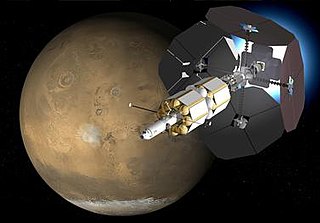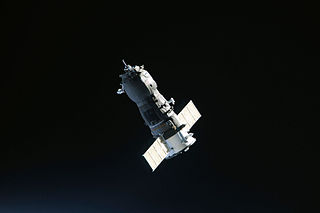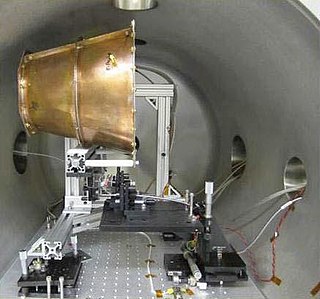Related Research Articles

Interstellar travel is the hypothetical travel of spacecraft from one star system, solitary star, or planetary system to another. Interstellar travel is expected to prove much more difficult than interplanetary spaceflight due to the vast difference in the scale of the involved distances. Whereas the distance between any two planets in the Solar System is less than 55 astronomical units (AU), stars are typically separated by hundreds of thousands of AU, causing these distances to typically be expressed instead in light-years. Because of the vastness of these distances, non-generational interstellar travel based on known physics would need to occur at a high percentage of the speed of light; even so, travel times would be long, at least decades and perhaps millennia or longer.

Jet Propulsion Laboratory (JPL) is a federally funded research and development center in Pasadena, California, United States. Founded in 1936 by Caltech researchers, the laboratory is now owned and sponsored by the National Aeronautics and Space Administration (NASA) and administered and managed by the California Institute of Technology.

Spacecraft propulsion is any method used to accelerate spacecraft and artificial satellites. In-space propulsion exclusively deals with propulsion systems used in the vacuum of space and should not be confused with space launch or atmospheric entry.

An ion thruster, ion drive, or ion engine is a form of electric propulsion used for spacecraft propulsion. An ion thruster creates a cloud of positive ions from a neutral gas by ionizing it to extract some electrons from its atoms. The ions are then accelerated using electricity to create thrust. Ion thrusters are categorized as either electrostatic or electromagnetic.

The Variable Specific Impulse Magnetoplasma Rocket (VASIMR) is an electrothermal thruster under development for possible use in spacecraft propulsion. It uses radio waves to ionize and heat an inert propellant, forming a plasma, then a magnetic field to confine and accelerate the expanding plasma, generating thrust. It is a plasma propulsion engine, one of several types of spacecraft electric propulsion systems.

Uncrewed spacecraft or robotic spacecraft are spacecraft without people on board. Uncrewed spacecraft may have varying levels of autonomy from human input; they may be remote controlled, remote guided or autonomous: they have a pre-programmed list of operations, which they will execute unless otherwise instructed. A robotic spacecraft for scientific measurements is often called a space probe or space observatory.

Franklin Ramón Chang-Díaz is an American mechanical engineer, physicist and former NASA astronaut. He is the sole founder and CEO of Ad Astra Rocket Company as well as a member of Cummins' board of directors. He became an American citizen in 1977.

A CubeSat is a class of miniaturized satellite with a form factor of 10 cm (3.9 in) cubes. CubeSats have a mass of no more than 2 kg (4.4 lb) per unit, and often use commercial off-the-shelf (COTS) components for their electronics and structure. CubeSats are put into orbit by deployers on the International Space Station, or launched as secondary payloads on a launch vehicle. As of December 2023, more than 2,300 CubeSats have been launched.

The Boeing X-37, also known as the Orbital Test Vehicle (OTV), is a reusable robotic spacecraft. It is boosted into space by a launch vehicle, then re-enters Earth's atmosphere and lands as a spaceplane. The X-37 is operated by the Department of the Air Force Rapid Capabilities Office, in collaboration with United States Space Force, for orbital spaceflight missions intended to demonstrate reusable space technologies. It is a 120-percent-scaled derivative of the earlier Boeing X-40. The X-37 began as a NASA project in 1999, before being transferred to the United States Department of Defense in 2004. Until 2019, the program was managed by Air Force Space Command.

The EmDrive is a concept for a thruster for spacecraft, first written about in 2001. It is purported to generate thrust by reflecting microwaves inside the device, in a way that would violate the law of conservation of momentum and other laws of physics. The concept has at times been referred to as a resonant cavity thruster.

Busek Co. Inc. is an American spacecraft propulsion company that builds thrusters, electronics, and various systems for spacecraft.

The Asteroid Redirect Mission (ARM), also known as the Asteroid Retrieval and Utilization (ARU) mission and the Asteroid Initiative, was a space mission proposed by NASA in 2013; the mission was later cancelled. The Asteroid Retrieval Robotic Mission (ARRM) spacecraft would rendezvous with a large near-Earth asteroid and use robotic arms with anchoring grippers to retrieve a 4-meter boulder from the asteroid.

LISA Pathfinder, formerly Small Missions for Advanced Research in Technology-2 (SMART-2), was an ESA spacecraft that was launched on 3 December 2015 on board Vega flight VV06. The mission tested technologies needed for the Laser Interferometer Space Antenna (LISA), an ESA gravitational wave observatory planned to be launched in 2037. The scientific phase started on 8 March 2016 and lasted almost sixteen months. In April 2016 ESA announced that LISA Pathfinder demonstrated that the LISA mission is feasible.

The Advanced Propulsion Physics Laboratory or "Eagleworks Laboratories" at NASA's Johnson Space Center is a small research group investigating a variety of theories regarding new forms of spacecraft propulsion. The principal investigator is Dr. Harold G. White.

Psyche is a NASA space mission launched on October 13, 2023 to explore the origin of planetary cores by orbiting and studying the metallic asteroid 16 Psyche beginning in 2029. NASA's Jet Propulsion Laboratory (JPL) manages the project.

Payload Aerospace S.L. is a Spanish company developing two partially-reusable launch vehicles called Miura 1 and Miura 5.
Cislunar Explorers is a pair of spacecraft that will show the viability of water electrolysis propulsion and interplanetary optical navigation to orbit the Moon. Both spacecraft will launch mated together as two L-shaped 3U CubeSats, which fit together as a 6U CubeSat of about 10 cm × 20 cm × 30 cm.

The Power and Propulsion Element (PPE), previously known as the Asteroid Redirect Vehicle propulsion system, is a planned solar electric ion propulsion module being developed by Maxar Technologies for NASA. It is one of the major components of the Lunar Gateway. The PPE will allow access to the entire lunar surface and a wide range of lunar orbits and double as a space tug for visiting craft.
References
- ↑ "Paulo Lozano". MIT. Retrieved May 7, 2017.
- ↑ "Paulo Lozano". Google Scholar. Retrieved May 7, 2017.